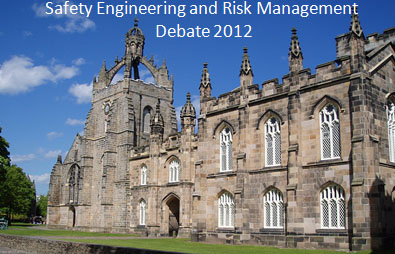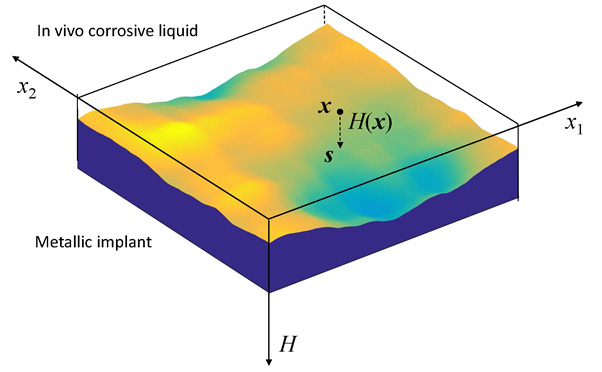Safety Engineering and Risk Management Debate 2012

Discussion Topic 6: Discuss safety in wind energy.
Safety Engineering and Risk Management Debate 2012

Discussion Topic 6: Discuss safety in wind energy.
Safety Engineering and Risk Management Debate 2012

Discussion Topic 7: Discuss safety considerations in wave energy system.
Safety Engineering and Risk Management Debate 2012

Discussion Topic 8: subsea integrity and reliability management
Safety Engineering and Risk Management Debate 2012

Discussion Topic 9: Safety and risk management in oil and gas industry
The discussions in this blog relate to the SUT (Society of Underwater Technology) event on Wednesday (10 October 2012), “Macondo - Lessons and implications for the North Sea”.
1, Presciptive VS Performance base
node/13485#comment-21159
2, Wave and tidal energy
node/13346#comment-20356
...
Safety Engineering and Risk Management Debate 2012
Which one is better, MyAberdeen or iMechanica, for debating topics relate to safety engineering and risk management?

I saw that every 2 or 3 minutes came out a new post. Tomorrow is the deadline, and you are all crazy! Take a break and have some free chat.
The book “Corrosion and Materials in the Oil and Gas Industries”, edited by Reza Javaherdashti, Chikezie Nwaoha and Henry Tan, has been published by CRC Press/Taylor and Francis LLC, USA.
user/971
a
The book “Corrosion and Materials in the Oil and Gas Industries”, edited by Reza Javaherdashti, Chikezie Nwaoha and Henry Tan, has been published by CRC Press/Taylor and Francis LLC, USA.
Since James Watt, a Scottish inventor, improve the efficiency of steam engine, human civilization relies more and more on a steady supply of energy. The re-rise as an international superpower and the global energy crisis are challenging China and the world. We are at a transitional age. On the one hand, we see the technology advances in exploration and development of oil and gas, a depleting resource; and the growth in handling ageing and decommissioning. On the other hand, we see ideas and plans for new energy structure in the future.
The discussions here relate to a conference I am chairing, the International Symposium on Energy Challenges and Mechanics, held in this summer at Aberdeen, Scotland, the energy capital of Europe. This theme is about energy challenges and the role of mechanics as a means for seeking solutions, involving multiple disciplines in technology, science and management. The topics include both fossil fuels and many different forms of renewable energy. In addition, we will discuss the role of mechanics in issues related to energy efficiency, safety and environment.
The discussion sessions developed include:
I. Fossil fuels related
II. Renewable energy related
III. Energy efficiency, safety and environment
IV. General
Professor Michael Kelly FRS FREng, Prince Philip Professor of Technology, University of Cambridge, gave the Closing Plenary at the 2nd International Symposium on Energy Challenges and Mechanics, hosted by the North Sea Conference and Journal.
Michael wrote the speech into an article, “Future energy needs and engineering reality”. The paper was published in the Journal of Energy Challenges and Mechanics.
http://www.nscj.co.uk/JECM/JECM1-3.html
The paper link is
http://www.nscj.co.uk/JECM/PDF/1-3-1-Kelly.pdf
This is the first serious attempt to review the progress over the last 20 years towards decarbonizing the world economy by 80% by 2050. Taking general lessons from the introductions of new technologies over the past 200 years, one can see that the targets are not going to be met, and in some cases matters are being made worse.
4th International Symposium on Energy Challenges and Mechanics - working on small scales

Session 11: NANOMECHANICS (http://nscj.co.uk/ecm4/sessions/session11.html)
Mechanical properties are crucial to better understand the final properties of applicable materials. From this point of view Nanomechanics is an important Nanoscience branch, which allows to study fundamental mechanical properties at the nanoscale. This knowledge is key point for the application of novel materials.
All research investigations done recently in the field of Nanomechanics are welcome to be discussed in this session in order to better understand mechanical behavior of the materials at the nanoscale.

3rd International Symposium on Energy Challenges and Mechanics - towards a big picture
7th-9th July 2015, Aberdeen, United Kingdom, the Energy Capital of Europe
Conference website
Conference Guide
Programme
Plenary lectures
Parallel sessions

Since James Watt, a Scottish inventor, improved the efficiency of steam engine, human civilization relies more and more on a steady energy supply. Today, the world is poised on the brink of two historic energy transformations: replacing oil with electricity in transportation, and replacing high carbon, finite-supply coal and natural gas with renewable wind, solar, marine and biomass energies for electricity production. This symposium is about current state of the art small scale technologies being applied to solve energy challenges,

Since James Watt, a Scottish inventor, improved the efficiency of steam engine, human civilization relies more and more on a steady supply of energy. Today we are at a transitional age. On one hand, we see technology advances in the exploration and development of oil and gas, a depleting resource; we see growth in handling aging and decommissioning. On the other hand, we see ideas and plans for the future's new energy structure. This symposium is about energy challenges, the underlying energetic basis (mechanics) for society, involving multiple disciplines in technology, science, management and policy-making. The topics include both fossil fuels and many different forms of renewable energy. In addition, we will discuss issues related to energy policy and economy, energy efficiency, safety and environment. The purpose is to gain a big picture about energy challenges and solutions.
As an example, here we discuss implant-associated infection from the mechanics point of view on bacteria adhesion affected by the biomaterial surface roughness:

1. Implant-associated infection, a leading cause of failure in many biomedical devices, is caused by adhesion of bacteria to the surface of biomaterials. Implant-associated infection is difficult to treat, for example, joint replacement infections may occur deep around the artificial implants.
2. Microbial adhesion and subsequent biofilm formation are mediated by van der Waals attractive forces, electrostatic repulsive forces, and surface hydrophobicity. The predominance of these forces is dependent on the distance between the microorganism and the surface, usually at distances greater than 50 nm van der Waals forces are the main factor, while at closer distances (10−20 nm) a combination of both van der Waals forces and electrostatic interactions controls cell adhesion.
3. Implant surface roughness is an important property relevant for the bacterial adhesion process, with the irregularities of the surfaces normally promoting bacterial adhesion and colonization.
4. For metals used in medical implants, the desired surface roughness is usually below 10 nm. At nanometre scale rough surface promotes friction, hence reduces the mobility of the bacteria; this sessile environment expedites the biofilm growth.
5. To reduce the roughness, surface nanotopography of medical implants is an important approach that can control the extent of bacterial adhesion.
6. Surrounding the implant are soft and hard tissues, as well as the corrosive body liquid. Whether the roughness of an initially nanoscale smooth surface will grow or decay is of crucial importance for implant devices.
7. For a stress metal implant under shallow chemical etching, the roughness with spatial frequency below a critical value grows while the roughness of higher frequency decays.
8. A rougher surface had lower constraint for electrons to escape from peaks, resulting in lower chemical potential.
References:
Tan, H. (2016) In vivo surface roughness evolution of a stressed metallic implant. Journal of the Mechanics and Physics of Solids, 95, 430–440.
Truong, V.K., Pham, V.T.H., Medvedev, A., Lapovok, R., Estrin, Y., Lowe, T.C., Baulin, V., Boshkovikj, V., Fluke, C.J., Crawford, R.J., Ivanova, E.P. (2015) Self-organised nanoarchitecture of titanium surfaces influences the attachment of Staphylococcus aureus and Pseudomonas aeruginosa bacteria. Appl. Microbiol. Biotechnol. 99, 6831-6840.
Ryu, J.J., Shrotriya, P. (2015) Mechanical load assisted dissolution response of biomedical cobalt-chromium and titanium metallic alloys: Influence of in-plane stress and chemical environment. Wear 332-333, 662-668.
Desrousseaux, C., Cueff, R., Aumeran, C., Garrait, G., Mailhot-Jensen, B., Traoré, O., Sautou, V. (2015) Fabrication of acrylonitrile-butadiene-styrene nanostructures with anodic alumina oxide templates, characterization and biofilm development test for Staphylococcus epidermidis. PLoS ONE 10, Article number e0135632.
Yoda, I., Koseki, H., Tomita, M., Shida, T., Horiuchi, H., Sakoda, H., Osaki, M. (2014) Effect of surface roughness of biomaterials on Staphylococcus epidermidis adhesion. BMC Microbiology 14, 234-240.
Wang, J., Yao, J., Gao, H. (2012) Specific adhesion of a soft elastic body on a wavy surface. Theoretical and Applied Mechanics Letters, Article 014002.